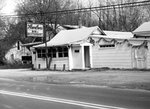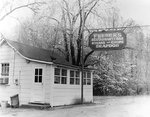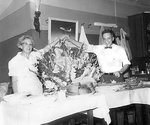 Severna Park
Severna ParkFair, 47°
Wind: 0.0 mph, N
 Severna Park
Severna Park




In the early stages of growth in Severna Park and Arnold, visiting a restaurant was as much a social occasion as it was a search for a good meal. Thanks to a handful of entrepreneurs, good meals and good conversation could be found as easy as pie.
Betty Winkelmeyer Wells, daughter of Walter and Jane Winkelmeyer, saw Severna Park’s development over several decades. Her parents opened a feed store and coal yard in 1947. The store later transitioned into a hardware store.
“Restaurants in Severna Park played such a critical role in the growth of the community,” Winkelmeyer Wells said. “All the merchants in Severna Park lived in the area and all their kids went to school here.”
These are a handful of restaurants that area residents still have fond memories of many years later.
Millhausen’s Tavern
Millhausen’s Tavern opened at the intersection of Benfield Road and Jumpers Hole Road with a ribbon-cutting ceremony in July 1937. Known for shuffleboard and beer, Millhausen’s started as a tavern before becoming a full-service restaurant that satisfied the appetites of customers hankering for burgers, roast beef, crab soup, or any other number of meals. Millhausen’s stayed in business until the 1980s.
Street’s
This establishment was located diagonally across the street from Millhausen’s, until 1936. Street’s was then relocated near the intersection of B&A Boulevard and Cypress Creek Road.
As lifelong Severna Park resident Scott Jay recalled, Street’s was the neighborhood watering hole where neighbors gathered to share local news and information about soldiers overseas.
“The neighbors created a newsletter called The Tap-Loid featuring articles and stories from Severna Park for over 122 subscribers in the armed services,” Jay wrote last year in the Severna Park Voice. “Down the street from Street’s Restaurant was another favorite with the locals, Feeser’s Restaurant, which served the best crab cakes around.”
Feeser’s
With black-and-white televisions and a print of Custer’s Last Stand, the interior of Feeser’s was unmatched.
Feeser’s was owned and operated by Harry and Anita Feeser, who opened the restaurant in 1932. A neighborhood hangout, Feeser’s sold beer, food and gasoline.
In the 1996 book “Severna Park Reflections: An Album of Memories,” Harry and Anita’s granddaughter, Phyllis Feeser Liley, said Baltimore Sun cartoonist Richard Yardley was a frequent patron of Feeser’s and featured the restaurant in his cartoons.
Susan Yardley Wheltle noted how the wooden building always seemed slightly tilted, and the restaurant was divided into four distinct spaces: the bar, kitchen, dining room and restrooms.
“The first space, dominated by a high wooden bar and barstools, was Harry’s domain,” she wrote. “Like the proprietor of a wooden pub, he loved conversation, knew all of his regular customers, and had the reputation for discouraging some new arrivals with a withering glance and stony silence. Some people, my parents among them, were welcome to stay all day; others left rather abruptly.”
Harry provided Wheltle with a seemingly limitless supply of food: Cokes, peppermint patties, and pistachio nuts.
“When adult conversation got boring, someone would hand me a dozen nickels, which I would cheerily gamble away in the slot machine opposite the bar,” she said.
As Earl Anderson wrote in the book “Linstead on the Severn, A History,” Harry would close the bar to patrons he did not like, but everyone there enjoyed the music.
“No one would know that there were a lot of ex-GIs there,” Anderson said. “Then all of the sudden, the piano player would start to play ‘Anchors Aweigh,’ or the Air Force song, and the guys would stand up and they’d sing and they’d hit their mugs on the table. Then he played ‘From the Halls of Montezuma’ and a couple of Marines would stand up and everybody sang and cheered.”
Winkelmeyer Wells remembers musicians playing rinky tink piano.
“Anybody who was anybody wanted to be there,” she said. “It was lively.”
The kitchen was Anita’s domain, where she made fried crab cakes, fried shrimp, fried ham, fried pork chops and fried steaks. A full-course dinner, pie included, cost less than $2.
“Her cooking methods might make a 1990s nutritionist blanch, but the tastes she created were fabulous,” Wheltle wrote. “She literally cooked all day, and most of the night.”
The restaurant continued in business until the 1960s when it was purchased by Charlie and Marcie Hamlen.
Hamlen’s
Known for its crab cakes, burgers and fried chicken, Hamlen’s was a family run restaurant in the heart of Severna Park. Charlie Hamlen oversaw the bar, and his wife, Marcie Hamlen, ran the kitchen. Daughters Cheryl and Carla served food and beverages to customers.
The décor was befitting of the times, too. Hamlen’s had red checkered tablecloths, a piano in the corner, and a ceiling fan. With some patrons being members of Colts Corral 27, Marcie often shepherded six busloads of fans to home games at Memorial Stadium. According to an obituary printed in 2020, Marcie was the largest season ticket holder the Baltimore Colts had for 17 years.
For 26 years, Hamlen’s was a family business. The restaurant was torn down in 1992 and replaced with an office complex.
Wagon Wheels
The luck of the Irish must have been with G. Carrigan “Fitz” FitzGerald, who was born on St. Patrick’s Day in Ireland in 1916. He and partner, Charles “Chuck” Greco, purchased the Emoclew Inn and renamed it Wagon Wheels, taking the name from the indoor lighting fixtures.
FitzGerald operated Wagon Wheels, a steak and seafood joint, from 1950 to 1985, with Greco selling his interest in the restaurant in 1959.
Located near Jones Station Road, where the Rite Aid is now, Wagon Wheels invited guests inside to an area with large open space and a ceiling held together with huge beams that crisscrossed.
FitzGerald’s wife, Esther, quit her job as a nurse at the Naval Academy to help run the business. Things did not always go smoothly.
“I remember one spring day, I spent the whole day planting 100 pink geraniums out front,” she recalled, in a piece published in the “Reflections” book. “That night, when I left the restaurant, I saw that someone had carefully pulled them all up and placed them on the hoods of the cars up and down the parking lot.”
Her experience wasn’t all bad. Esther praised her customers and the fire department.
“Through the years, the Wheels became a meeting place for businessmen, sports personalities, and politicians,” she said. “Fitz got to know many very interesting people and enjoyed them all. The people of Severna Park were very good neighbors and friends. I hope we were good neighbors, too.”
Comments
No comments on this item Please log in to comment by clicking here